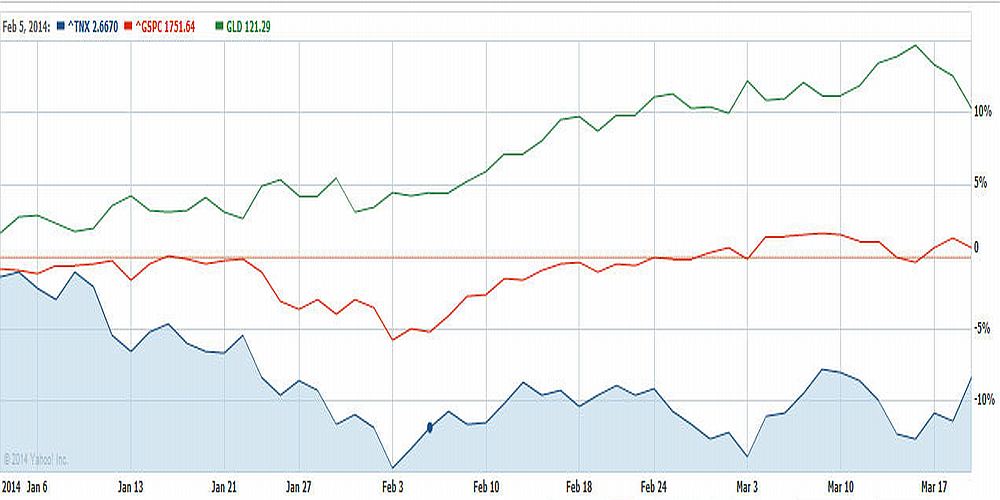Look Ahead
Fed Reduces QE And Investors Reduce Risk Appetite
This week’s Federal Reserve FOMC meeting was the first headed by new Chair Janet Yellen. Among the other novelties of this meeting was the removal of the Fed’s quantitative guidance on the level of unemployment that the Fed deems noteworthy as an indication of future inflation. The FOMC statement and the subsequent remarks made by Yellen at her press conference gave way to great confusion and misinterpretation among traders and led to a seesaw session on Wall Street with a 100+ point swing on the Dow Jones Industrial average.
Though some of Yellen’s comments are open to different interpretations, the Fed’s actions are crystal clear: The Fed announced a $10 Billion further reduction in its asset purchase program or QE. While many believe the Fed is reducing its asset purchases due to an improving economy and a gradually decreasing unemployment rate – with maximum employment being one of the Fed’s objectives given its dual mandate – however, many forget the Fed’s second mandate which is price stability. Clearly, the Fed is not happy with inflation expectations and thinks they are too low. However, as Bernanke alluded to before, the FOMC has come to the conclusion that, given its costs and benefits, QE is not the best tool to pump inflation and that forward guidance should be relied on more instead. Hence, it was not surprising the amount of time Janet Yellen spent explaining all the nuances of the change from quantitative to qualitative guidance.
Nevertheless, the reality is that the Fed is reducing stimulus while Yellen’s own assessment of the economic recovery is that it has been “disappointing”. If the Fed’s intent behind its multiple rounds of quantitative easing was to reduce interest rates and effectively push other asset prices higher (read stocks) then that was magnificently achieved in 2013 with the S&P 500 rising by more than 30%. However, that did not do much in raising inflation and that is the real reason in my opinion QE is being wound down in favor of forward qualitative guidance.
What matters to investors from the above discussion is the impact that Fed policy, and actions, will have on various asset classes. Everything else being equal, the best interpretation can be achieved if we can gauge investors’ risk appetite. So the best question we can ask is what will the new Fed policy do to investors’ risk appetite? Instead of trying to opine qualitatively on this issue, we should look at what the markets have been performing since the beginning of 2014:
Gold is up nearly 10%, Stocks are unchanged, while 10 Year Treasury bonds are yields have dropped by 7% since the beginning of the year currently yielding around 2.75% after starting the year near a 3% yield. Clearly, investors have adjusted their risk appetite after the Fed announced its QE taper in December 2013.
 Gold Versus Change in 10 Year Treasury Yields Versus S&P 500 Jan 2 – March 20Chart Courtesy Yahoo Finance
Gold Versus Change in 10 Year Treasury Yields Versus S&P 500 Jan 2 – March 20Chart Courtesy Yahoo Finance
One would think that Treasury yields would go up once the Fed reduced its bond buying program but the opposite has happened. Surely, it is the lack of inflation expectations but also it’s a reflection of a decrease in risk appetite. Similarly, Gold is not up because of inflation fears but because it is perceived as a safe haven in time of turmoil. One can argue that current geopolitical risks can be temporary, but nevertheless those risks do impact risk appetite. Lastly, the fact the S&P 500 is practically unchanged is further evidence that investors are not as enthused about stocks as they were in 2013. Back in August of 2013, I was anticipating the Fed to announce a reduction in QE in September and a drop in risk appetite by year’s end. The Fed ended up announcing the taper in December and we are now seeing this anticipated drop in risk taking.
Where to invest in 2014?
If the above scenario holds true, it would be prudent for investors to reign in their risk taking in 2014. Given the reality that short term interest rates are rising, risk appetite is declining and economic growth is sluggish, it would be wise to overweight defensive assets at the expense of more economically sensitive ones. Of the 10 S&P 500 sub-sectors, our favorite sectors to overweight include Utilities stocks for their defensive qualities. Financials as a group will benefit from rising short term interest rates and will likely reward investors with higher dividends and buybacks in 2014. Healthcare and Consumer Staples stocks are equal weight sectors in our opinion while Technology, Industrials, and Consumer Discretionary stocks are our least favorite. Gold continues to be a good hedge with a 10% portfolio weighting whereas allocations to Treasuries (10 Year+) should be higher than 25% while keeping a decent percentage in cash for opportunistic purchases – which we think there will be plenty.
Tagged Ben Bernanke, Federal Reserve, Janet yellen, Stocks
If you liked this article please follow us on Twitter and Facebook










